If you live in a climate with winters, outdoor gardening must be put on hold until the spring. However, this doesn’t have to be the case (at least not entirely). This article will explain exactly how to grow peppers indoors year round.
Peppers are perennial plants in nature, meaning that they can live for multiple years. Plants of the genus Capsicum originate in tropical climates with warm, often humid conditions. However, in colder climates, they will not survive a frost.
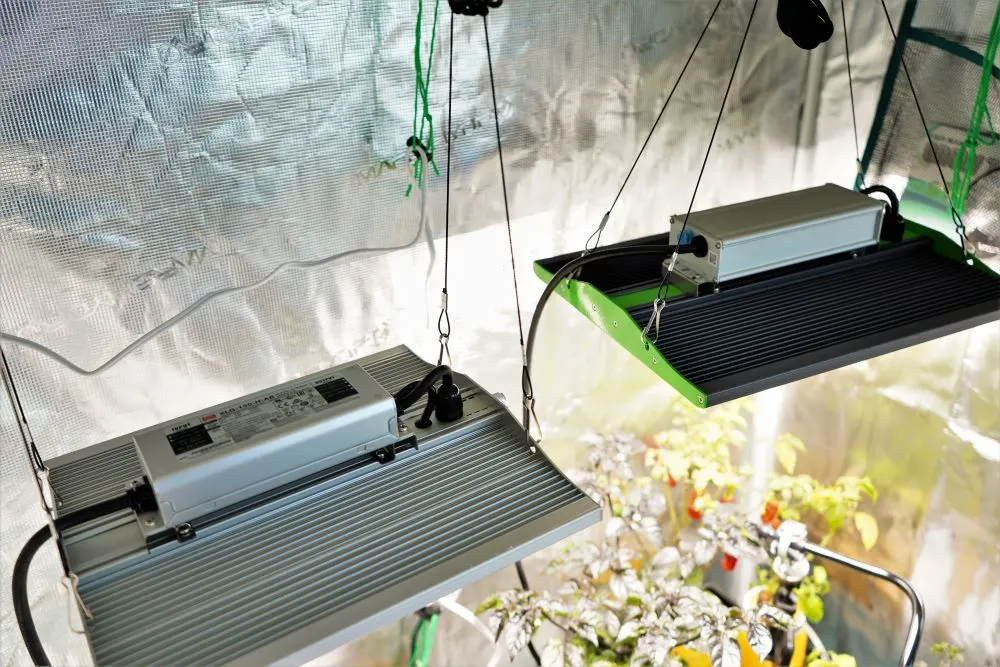
Thankfully, we can bring existing plants indoors to overwinter them. Or, if you prefer to keep your plants inside from the start, peppers can be grown indoors from seed to harvest.
If you want to learn how to grow peppers from seed outdoors, start with this guide.
This article will cover everything you need to know for growing peppers inside from start to finish. I’ll discuss the supplies you will need, along with the steps to get your plants growing strong indoors. Let’s get started!
In this article (skip ahead):
- Supplies
- Choosing varieties
- Grow lights
- Starting pepper seeds
- Pepper seedling care
- Transplanting
- Indoor care tips
- Encouraging fruiting
- Indoor pepper problems
- Bringing plants in from outdoors
Supplies
Without the help of the sun, rain, and pollinators, indoor pepper plants require a few additional items to be successful. The most important item will be a grow light, but there are a few other supplies to consider as well.
Essentials:
- Grow light – This is our favorite starter light
- Outlet timer – See on Amazon
- Small containers (1.5-3″ diameter, for seed germination)
- Large pots (1-3 gallon)
- Soil – We love this potting soil
- Fertilizer – Fox Farm trio makes it easy, Miracle Gro Organic is good too
- Spray bottle
- Seeds
These are the bare minimum if you expect to grow your peppers plants completely indoors. Without a grow light and timer, your plants may fail to produce fruits. A sunny window usually isn’t enough for fruiting, especially during winter.
If you intend to grow from seed, we have a few other recommended supplies that will help with germination. We also like to add a fan or two for good airflow.
Optional:
- Grow tent – These contain the bright light and provide a place to hang lights/fans
- Seedling heat mat – Improves germination rate by warming the soil
- Thermometer/hygrometer – To monitor temperature and humidity
- Fan – For improved airflow
With all of these items in hand, you should be ready to begin your indoor pepper growing adventure!
Pepper Variety Selection
Okay, I kind of lied. Choosing which type of pepper plant to grow indoors is almost as important as a proper setup. Some varieties just aren’t very easy to contain in a limited indoor space.
For example, ghost pepper plants can grow to be absolutely massive. On the other hand, Thai chilies are compact plants, perfect for a smaller space.
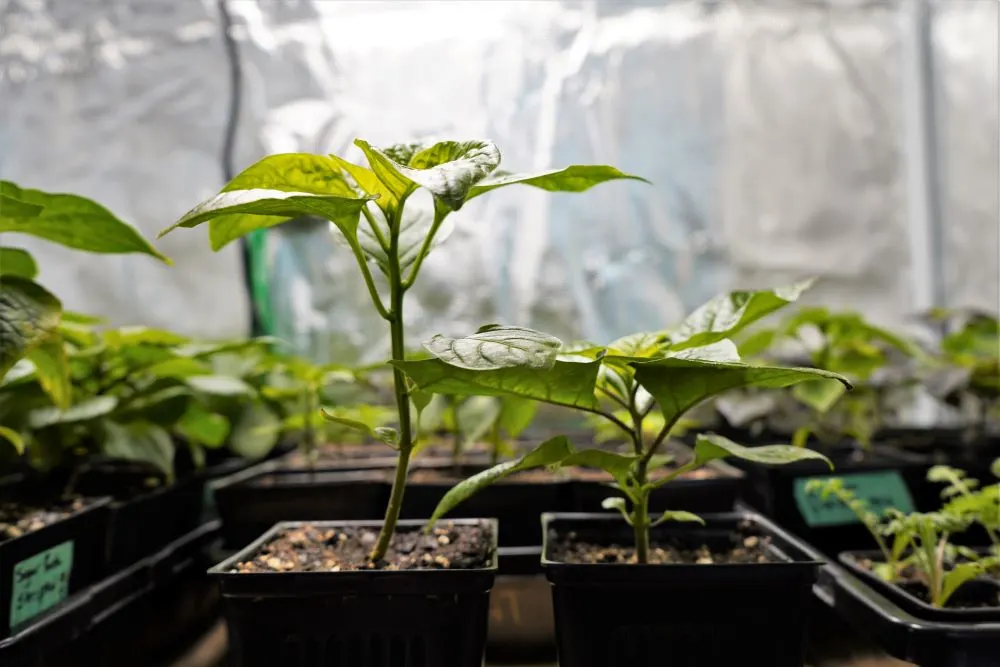
Smaller pod varieties (like scotch bonnets) will produce a greater number of fruits compared with larger types (like bell peppers). It is usually more satisfying to harvest a dozen smaller fruits instead of just 1 or 2 larger peppers.
Good Pepper Varieties to Grow Indoors
- Banana
- Piquillo de Lodosa
- Jalapeno
- Shishito
- Serrano
- Thai
- Fresno
- Ornamentals (Chinese 5 color, black pearl, etc.)
- Aji charapita
- Scotch bonnet
- Purira
Looking for seeds? Use our article for a list of good places to buy pepper seeds online.
You’ll notice bell peppers are not on this list, despite them being the most popular type. It is definitely possible to grow bell peppers indoors! However, it may be more of a challenge to get an abundance of fruits from an indoor plant. If it is the only variety you want to grow, by all means go for it!
Tip: If you want to grow a plant variety that tends to get big, plant it in a smaller container (~1 gallon) to keep the plant’s size smaller.
Choosing a Grow Light (and Tent)
If you are planning to get your very first grow light, shopping can become overwhelming. There are so many different companies offering similar, but slightly different styles of grow lights.
Let’s keep this really simple. Viparspectra grow lights are our favorite all around LED lights for the price. They offer a variety of budget-friendly, silent, cool-running lights that are highly efficient and long lasting.
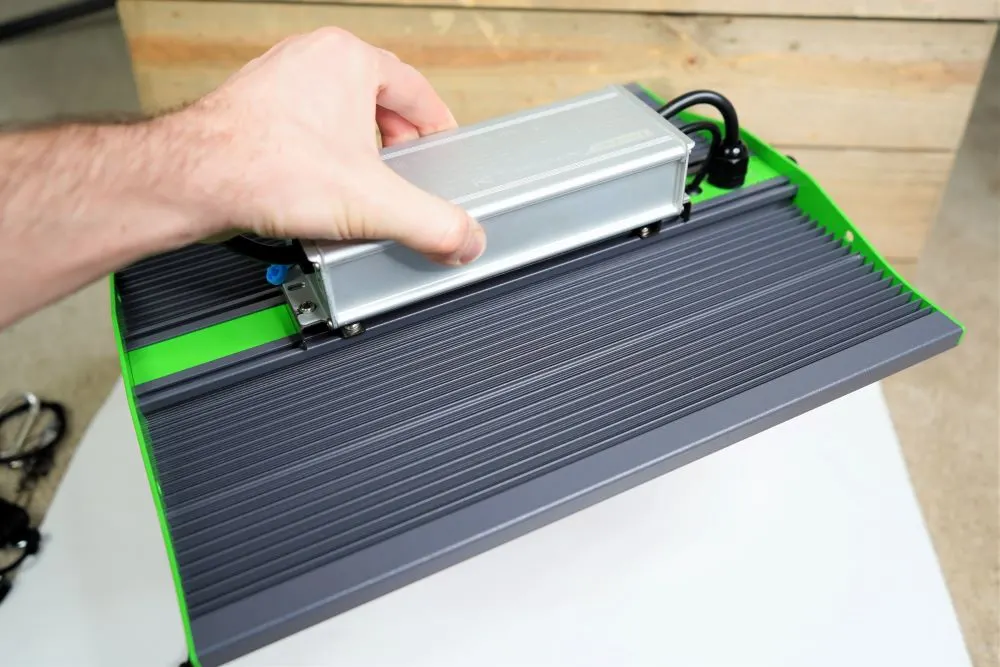
Some cheaper lights on the market are junk. We have tested lights that didn’t even last a single year. Since your lights will be running for 12+ hours per day for months at a time, you’ll want something built to last.
Feel free to go down a rabbit hole and learn everything you can to choose the perfect light. However, our current recommendation is to pick the right sized light from Viparspectra and move on!
Starting Pepper Seeds
Starting pepper seeds for growing indoors is no different than for growing outdoors. The seeds can take from 4-14+ days to germinate (depending on seed age and variety), so be prepared to wait.
Read our full article on how to germinate pepper seeds properly. Or, watch our instructional video here.
Steps:
- Label seed trays. Organization is key! It is too easy to lose track of which plant is which if you aren’t careful. We label our trays with tape and sharpie.
- Pre-moisten soil. We use a seed starter mix (no nutrients) for germination, but this isn’t required. Pre-moisten your soil with water and mix it thoroughly. The soil should be moist, but shouldn’t drip much water when squeezed.
- Fill containers with soil. Add the moist soil to your seed cells or small pots. The soil should be lightly compacted, just until you feel some resistance.
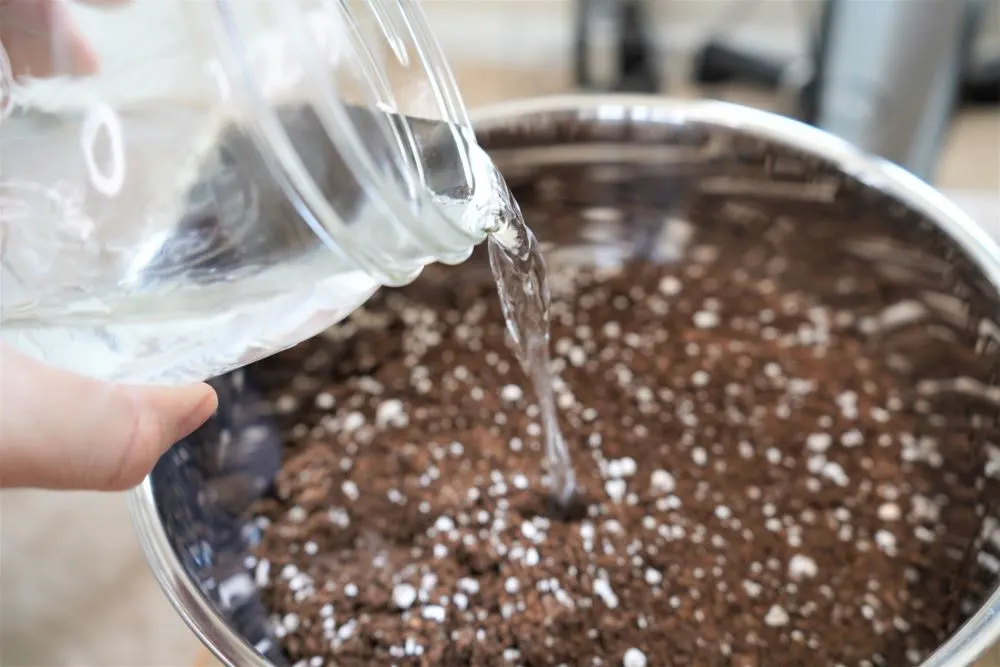
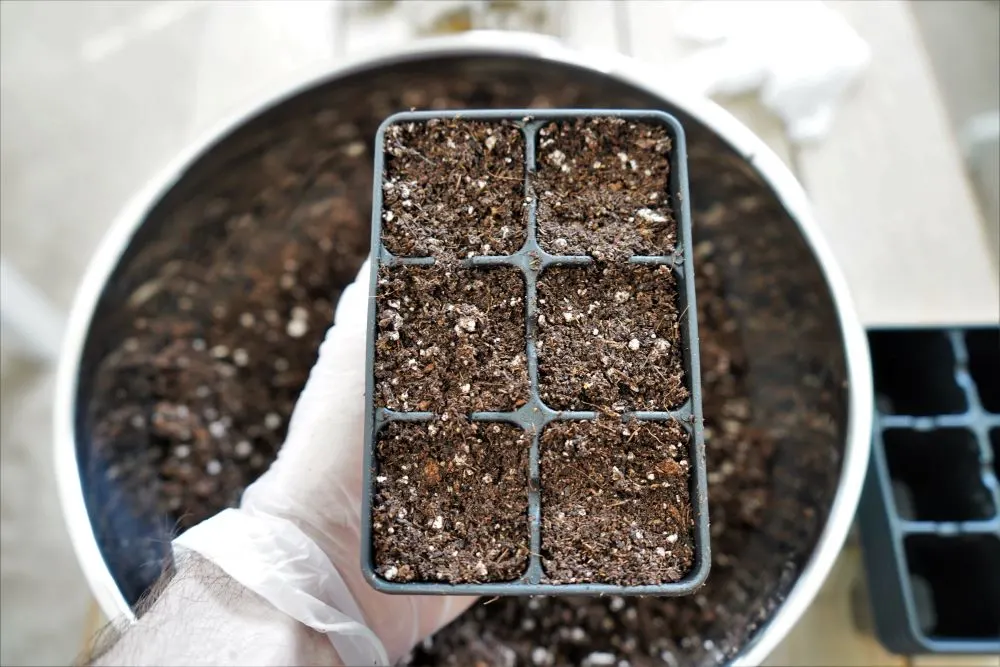
- Plant seeds 1/8-1/4″ deep. Pepper seeds shouldn’t be planted deeper than 1/4″, but should be covered with some soil. I use a pencil to make a small hole and drop 1-2 seed in. Then, cover them up with the surrounding soil.
- Mist the surface. Using a simple spray bottle, mist the surface and ensure the water reaches your seeds. The seeds need to stay moist constantly until they sprout, so this should be done daily!
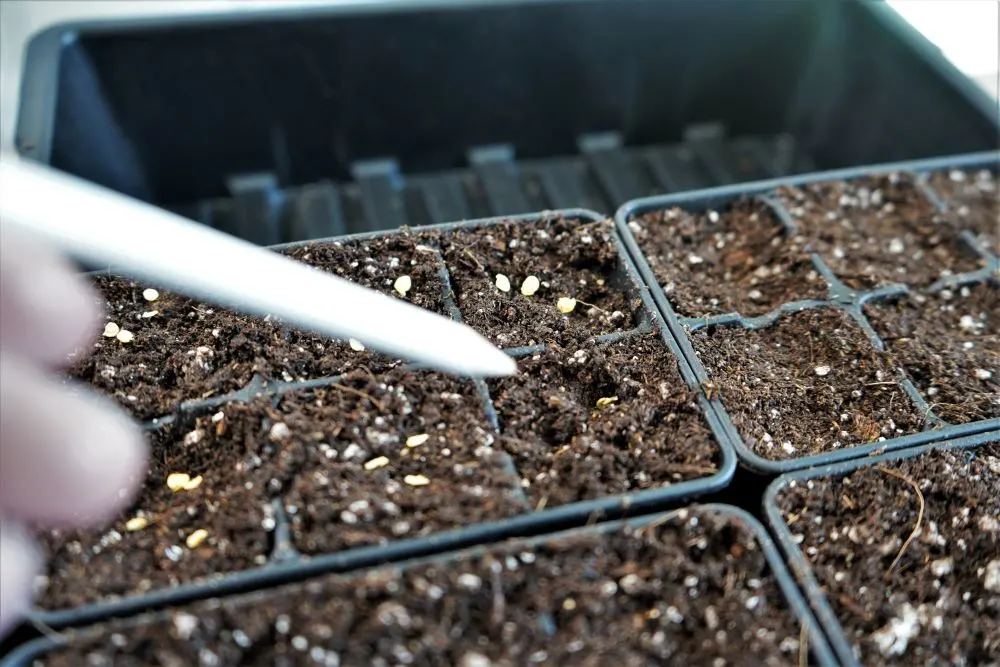
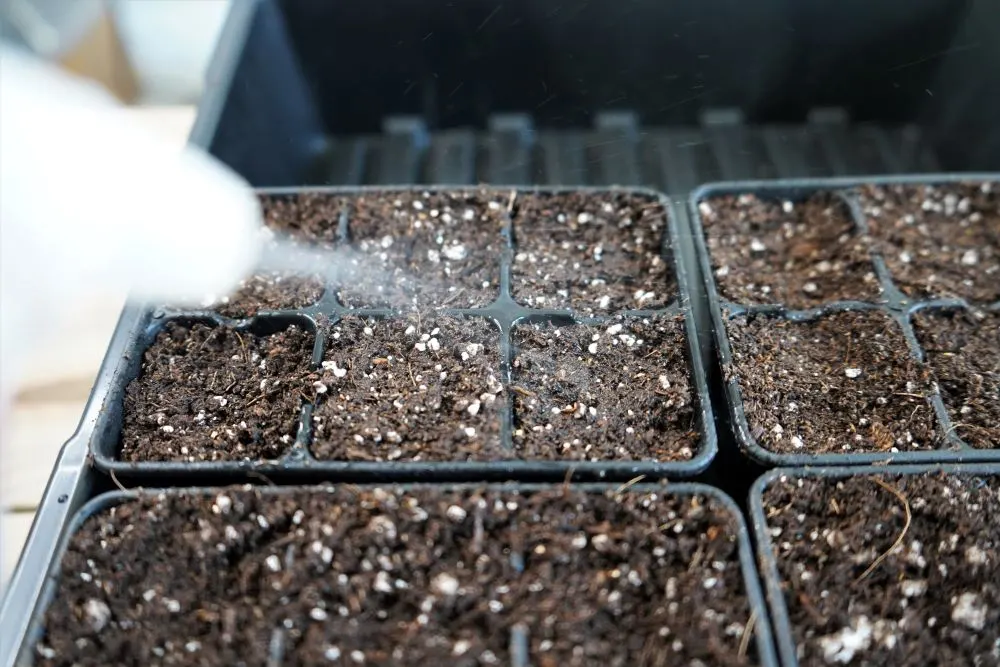
- Place in a warm, humid location. A warm temperature is key for successful germination. If it is cold where you are planting, there are some supplies that can help.
Other germination tips:
- Use a humidity dome to prevent drying out
- Fan out humidity dome daily
- Never pour water on the soil surface to avoid disturbing the seeds
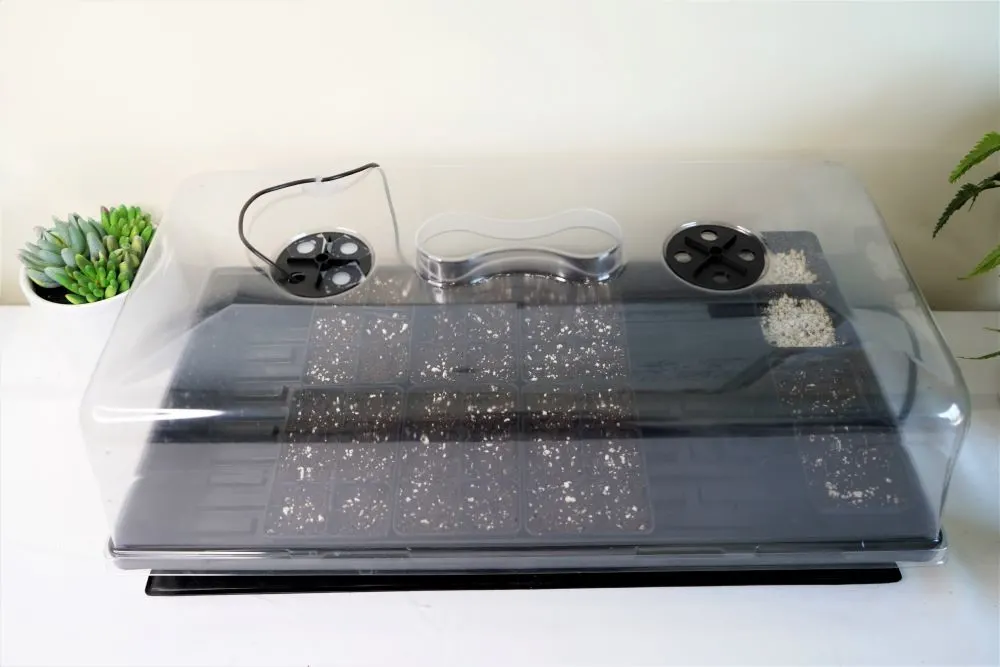
Optional – Use a heating mat
Warmth is the most important factor when it comes to quick germination. If your growing location is cold, you may want to invest in a seedling heat mat. These are essentially a heating mat with a thermostat built in.
This mat is placed under your seed cells to keep the soil warm until the seeds sprout. A thermostat turns the heating pad on whenever the temperature dips below your setting.
I like to keep the temperature set to 80°F (27°C) for the best germination time. We have seen superhot pepper seeds sprout in as little as 4 days using our mat!
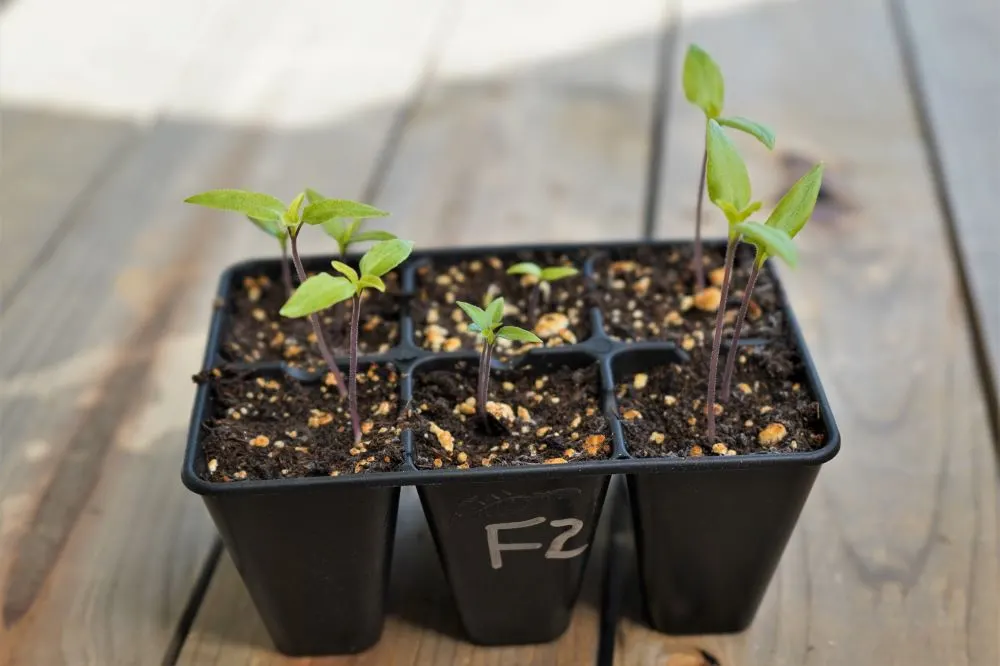
Seedling Growth Stage
Once your peppers sprout, they need to immediately move under grow lights. The plants need light to photosynthesize and begin forming a strong root system early on.
A sunny window is not ideal. This is one of the biggest mistakes that new pepper growers make, so don’t make it! If you are serious about getting a full-sized indoor pepper plant that actually produces fruit, you will need to use a grow light.
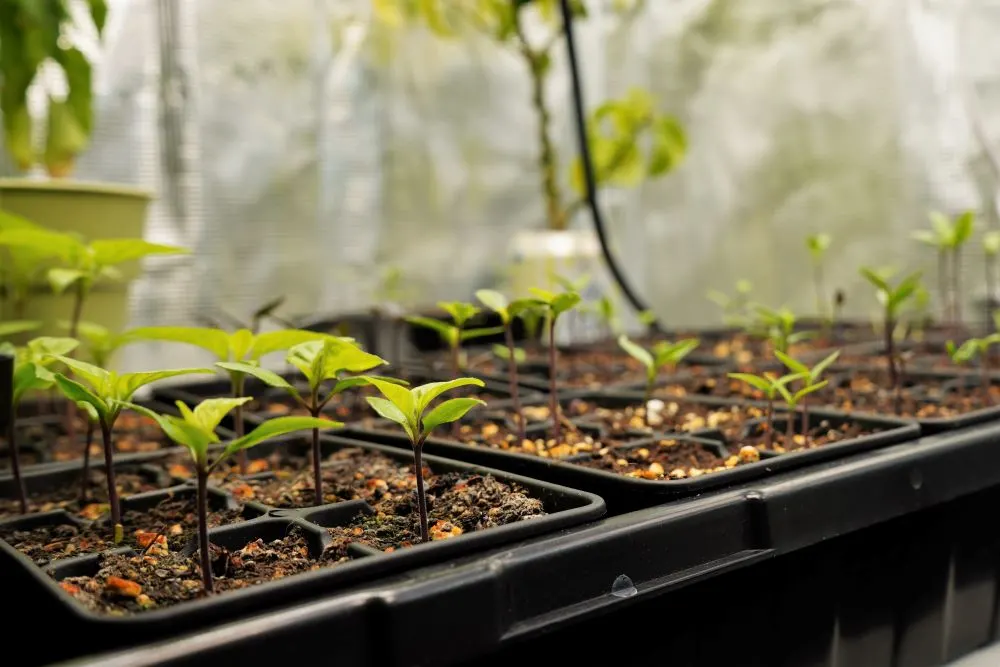
Tips for lighting young pepper plants:
- Light height. With our XS1500 LED, we start at 50% power at a height of around 18″ (46cm). This changes as the plants grow, but more on that later.
- On/off cycle. Early peppers do best with a longer on cycle. We recommend setting your outlet timer to 15 hours on, 9 hours off for the first several weeks of growth.
- Curling leaves. If your plants show curling leaves (like a taco shell), the lights may be too close or too strong. Raise the lights or reduce the power and watch for improvement.
- White spots. Intense light can burn young pepper leaves. Watch for sun scald and adjust the light height or intensity accordingly.
For the first 2-3 weeks, pepper plants grow very slowly. However, once the plants outgrow a typical 1.5″ seed cell, they will usually start to take off!
Watering Seedlings
I usually prefer to bottom water pepper seedlings to avoid disturbing the young, weak plants. However, if you have a small watering can, you can carefully water at each plant’s base.
Some of the best advice I can give is to never over-water peppers, especially at the seedling stage! This means allow the soil’s surface to become dry to the touch between waterings. Learn more about watering peppers here.
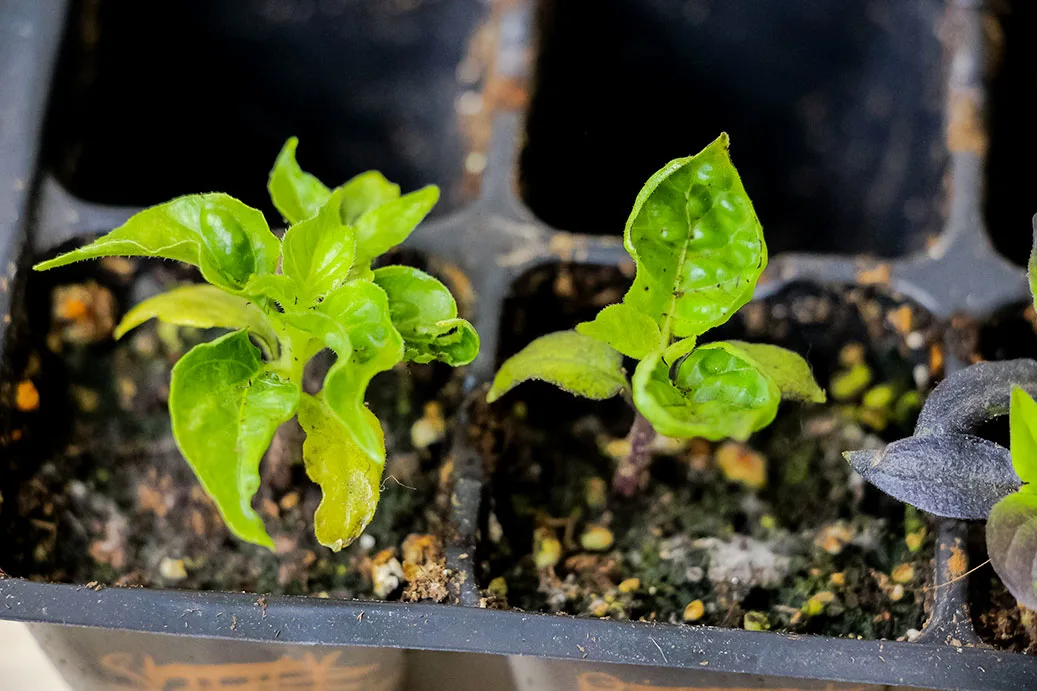
Another method to avoid overwatering is to dump out excess water drainage from your plant trays. Sitting water can cause the soil to remain soggy and cause root problems, pest issues, and fungus.
Overly wet soil is also the main cause of damping off disease, which kills young pepper plants. If your young pepper plants fall over at the base of the stem, you likely have damping off.
Fertilizing Seedlings
If you are using a soilless seedling mix, fertilizer is necessary once the plants are about 1 week old. If you planted in a soil with fertilizer, then you can wait until the plants are transplanted to start feeding.
To feed pepper seedlings, at 1 week old, apply an all purpose fertilizer at 1/4 strength. In other words, follow the manufacturer’s instructions, but reduce the quantity of fertilizer by 1/4.
After the initial feeding, fertilize weekly at 1/4 strength. After 2-3 weeks of this feeding regimen, and the plants are transplanted to larger containers, the strength can be increased.
Transplanting Peppers
Transplanting is the process of moving an entire plant from one container to another. Starting in a smaller container only to move to a larger one may seem counterintuitive. However, you save space and help prevent damping off by starting small.
In our experience, peppers are usually ready to be up-potted from 1.5″ seed cells at about 3 weeks old. To know for sure, check the root system to make sure it is reaching the bottom of the soil.
Why Container Size is Critical
For indoor growth, container size is vitally important. The size of the container will directly impact the size of the mature pepper plant. For a large ghost pepper type plant, using a smaller pot will keep the plant more compact and manageable.
If you are growing many varieties in a limited space, you can keep all of the plants relatively small by planting in smaller containers. For keeping pepper plants small, we recommend ~1 gallon pots. You could go even smaller, too!
However, for the largest indoor plant possible, a 3-5 gallon pot is enough for most varieties.
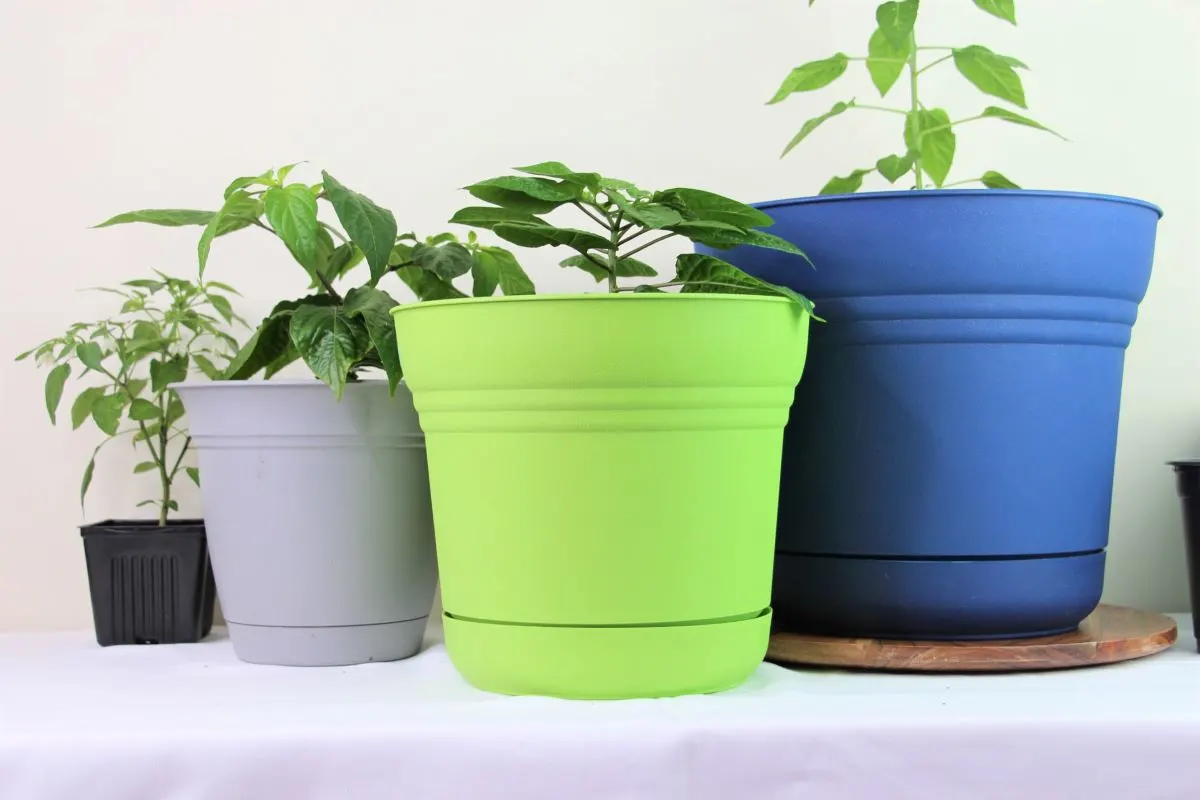
Choosing an Indoor Soil
Since pests can become a major issue, we always recommend using a fresh source of potting soil. Fox Farm’s Happy Frog soil is a wonderful medium that has not let us down yet.
Tip: Shopping for soil online can be expensive – call around your local nurseries to see what they carry.
If you want to bring soil in from the outdoors, be sure to sterilize the soil first. This essentially involves pouring boiling water into your soil and mixing it thoroughly. You can also bake the moist soil at a temperature of 200°F (93°C) to kill off insect eggs and pathogens.
Without proper sterilization, outdoor soil can bring in fungus gnats, aphids, and other unwanted pathogens. Outdoors, predators can take care of these pests. Indoors, the pests can multiply rapidly, running rampant in your grow space – no fun!
How to Transplant Peppers
Transplanting is fairly easy, though it does require some care to avoid damaging the plants. Essentially, prepare your larger pots with pre-moistened soil, dig out a small hole, and transfer the soil and roots to the new pot.
If you planted in seedling cells (1.5″ pots), your seedlings should be ready to move into larger pots after 2-3 weeks. They can then move into a medium sized pot (we use 3.5″ pots), or to their final pot size (1-5 gallons).
Read more on how to transplant peppers here.
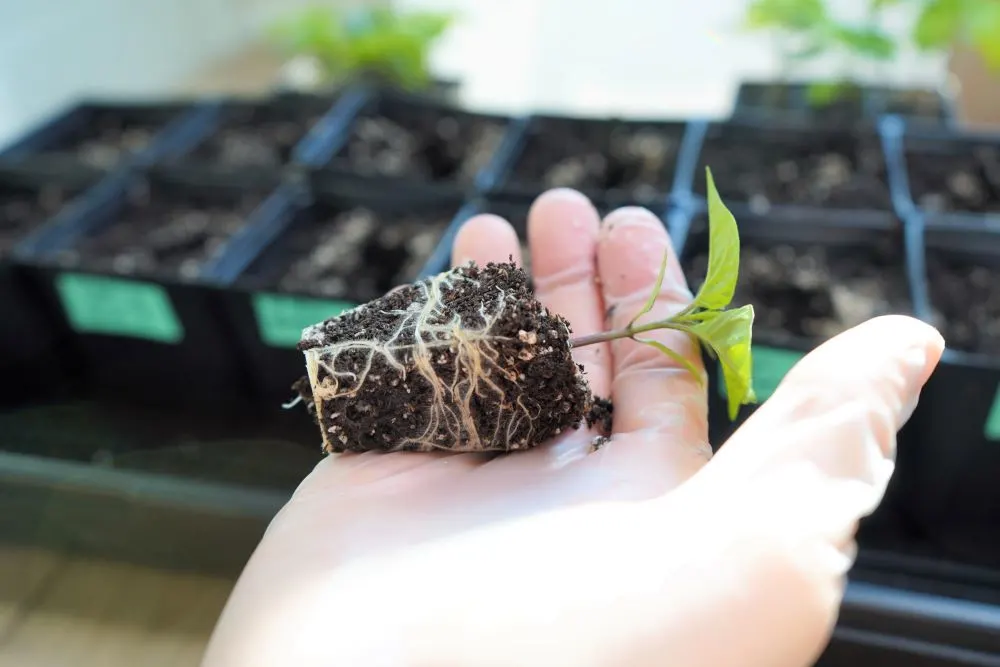
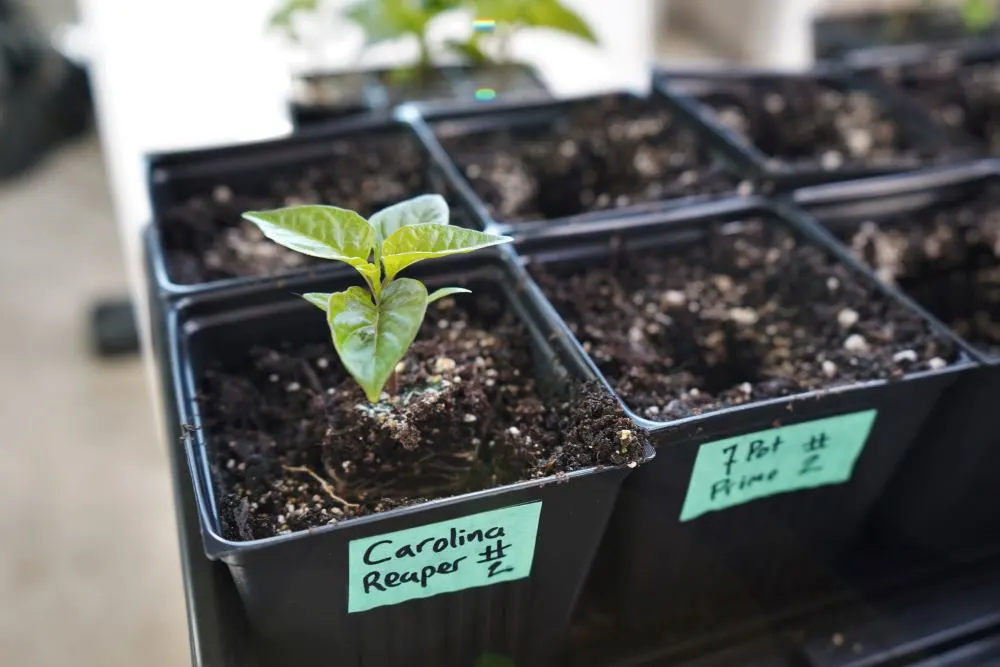
Once your plants are moved, tamp down the soil around the plant gently. Then, apply a thorough watering, allowing excess water to drain from the pot.
Tip: Plant your seedlings at the same depth as their original pots. Don’t bury the stem like you would a tomato plant, this can cause stem rot.
Increasing Light Intensity
As pepper plants grow, they will naturally become taller and use more of the available light. They will also become hardier and able to take more intense light. We begin increasing the intensity from 50% upwards after transplanting.
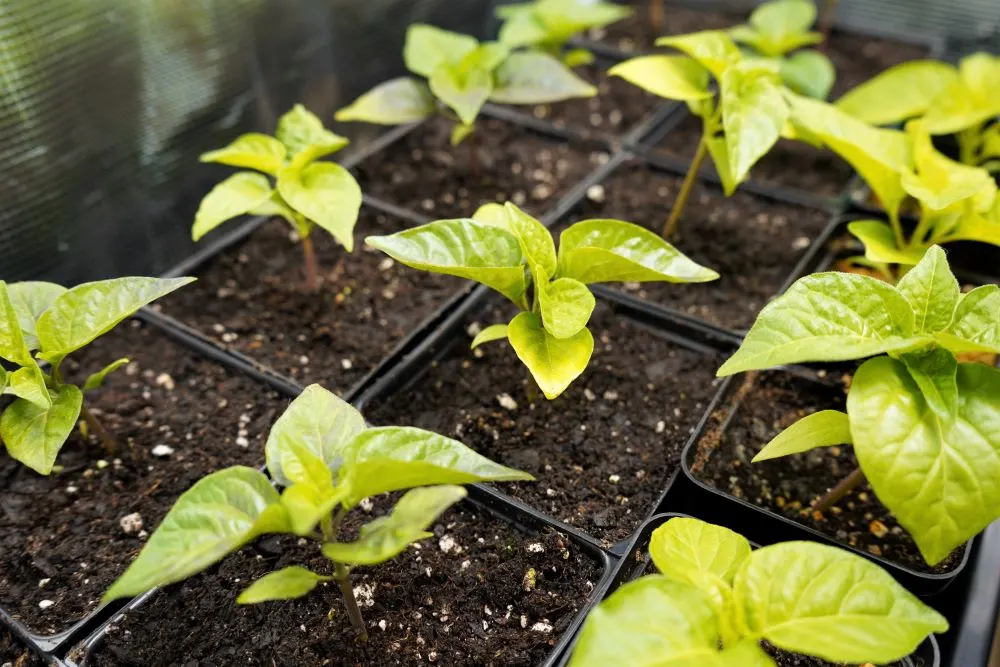
If your lights have a dimmer knob, increase intensity by 5% each week. This is essentially the indoor equivalent to hardening your pepper plants off to the outdoors.
Always be on the lookout for stressed plants from too much light. The height of the lights can usually remain in place, as the plants will grow taller and naturally get closer to the lights. We usually don’t go to 100% intensity with our P1500, instead maxing out around 75%.
Indoor Pepper Plant Care
As your pepper plants grow, they will require regular check-ins and care. Indoor plants usually don’t require as much water, as they are not exposed to the outdoor elements of wind, direct sun, and high temperatures.
Temperature for Growing Peppers
Temperature plays a key role in how quickly your indoor pepper plants grow. It can also stress the plants, whether it is too hot or too cold. We always keep track of temperature with a cheap thermometer.
Most pepper plants enjoy growing in temperatures between 70-80°F (21-27°C). This usually works out for indoor growing, as most homes are kept around 70°F. If your home is cooler, the grow lights will provide some extra heat for the plants.
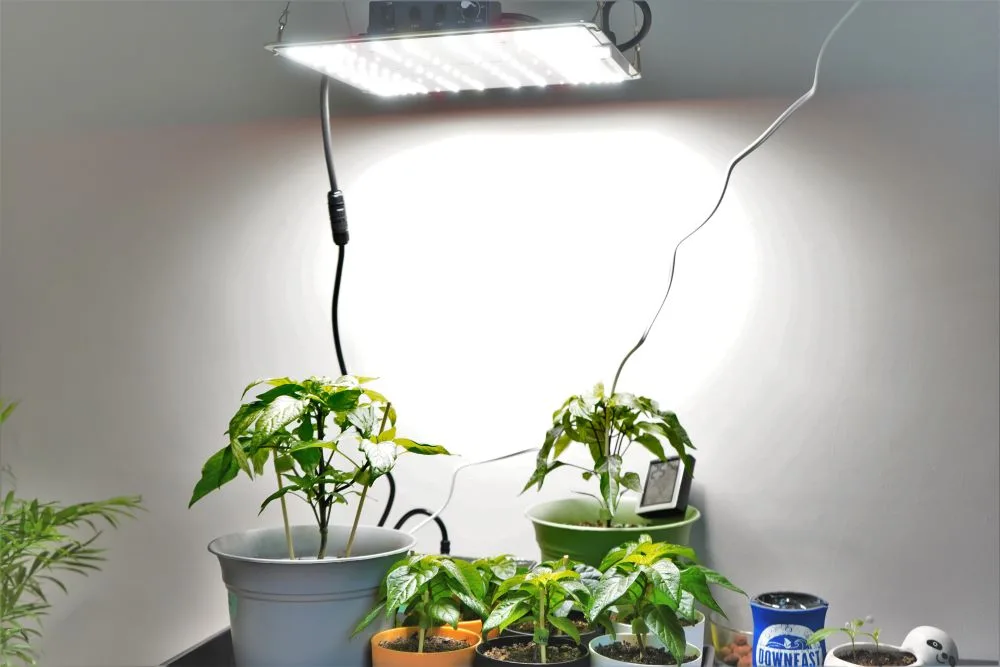
Cold temperatures will significantly slow down plant growth (anything below 65°F/18°C). Hot temperatures stress peppers too, leading to quicker water usage and sometimes flower drop.
Fertilizer
Once pepper plants are about 4″ (10cm) tall, we switch to a full-strength fertilizer regimen. Most fertilizers are meant to be applied once per week, though this can vary by brand and strength.
If you used a nutrient-rich soil, like Fox Farm, then we recommend waiting 1-3 months after transplanting before fertilizing (wait longer for larger pot size). These soils have slow-release nutrient sources that break down and provide the plants with food for many weeks.
Read more about fertilizing peppers here.
Humidity
If you are growing Capsicum annuum peppers, they will do best in moderate humidity (around 50-60%) and more light intensity. These peppers include jalapenos, banana peppers, bell peppers, and serranos.
Capsicum chinense species plants prefer a higher humidity (80-90%), and less intense lighting. This is thanks to the species’ origins in a tropical climate. These peppers include habaneros, scotch bonnets, ghost peppers, and 7 pot peppers.
Controlling humidity can be done with the combination of a humidity controller and a humidifier. This can be especially helpful for young plants. Once the plants are larger, they will produce moisture and help regulate humidity naturally.
Aeration
One of the key differences between growing peppers indoors vs outdoors is fresh air and wind. These may seem like low-importance factors, but without them, your plants may begin to show signs of stress.
We’ll discuss plant edema more later on, but this disorder is common in stuffy environments. To avoid this and other issues, always provide airflow with a fan, along with fresh air.
If you use a grow tent, fresh air is even more important. Plants produce oxygen, and require carbon dioxide to grow. If the grow space does not have a fresh source of air, the plants can begin to suffocate.
There are specific fans made for grow tents that suck in air from down low, and exhaust oxygen-rich air up high. In a closed grow tent system, this air movement is absolutely critical.
If you are growing your peppers in the open, one or two oscillating fans placed in the grow space are usually enough. If you can provide some fresh air from outdoors with an open window, all the better.
Getting Indoor Peppers to Produce Fruit 🌶
Depending on the pepper varieties you are growing, plants usually begin to fruit between 3-4 months after sprouting. The timing will also depend greatly on how large your containers are.
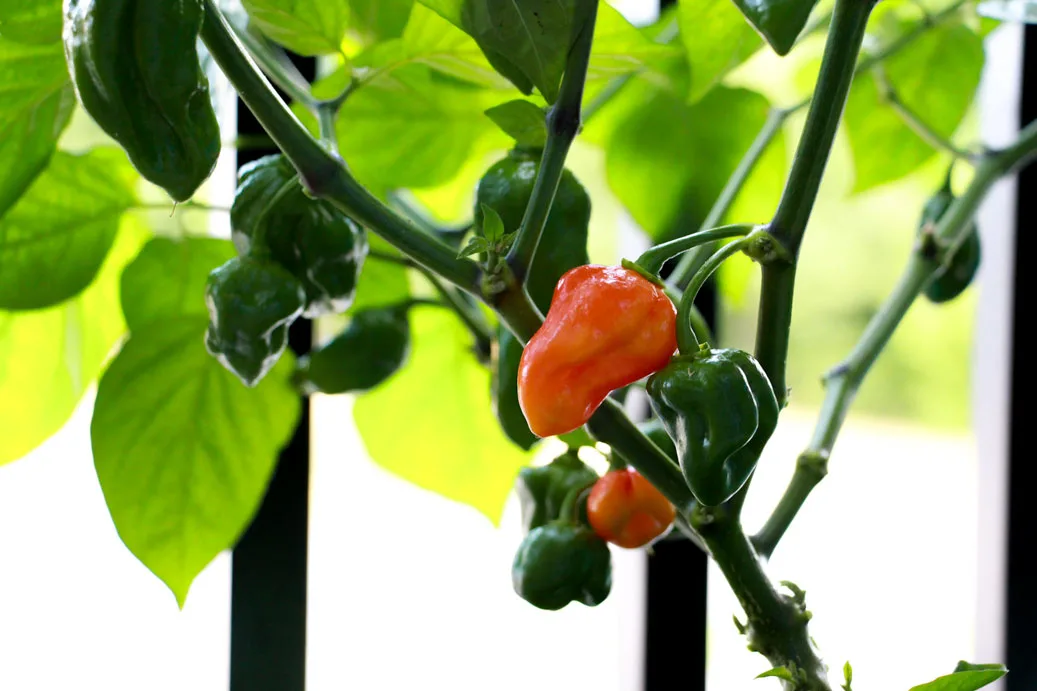
Change Fertilizers
Once your plants have reached a mature size (for the size of pot they are in), they will begin to produce flowers. Fruiting is triggered by both plant age and the roots running out of growing space.
Another factor is nutrient content. For optimal fruiting, pepper plants require plenty of phosphorus, potassium, and calcium. Nitrogen is less important (though it still does play a role in your plant’s health).
For this reason, we recommend switching to a reduced nitrogen blend fertilizer, like Tiger Bloom or Big Bloom. Alternatively, you can simply reduce the overall quantity of your all-purpose fertilizer.
This change will help to avoid a bushy, leafy pepper plant, and will encourage fruiting. Too much nitrogen signals your plants to keep growing more leaves and branches, rather than setting fruit and reproducing.
Encourage More Fruiting
So, how can you get any plant to produce more peppers indoors? We have some simple methods that have helped our plants be more productive when grown inside.
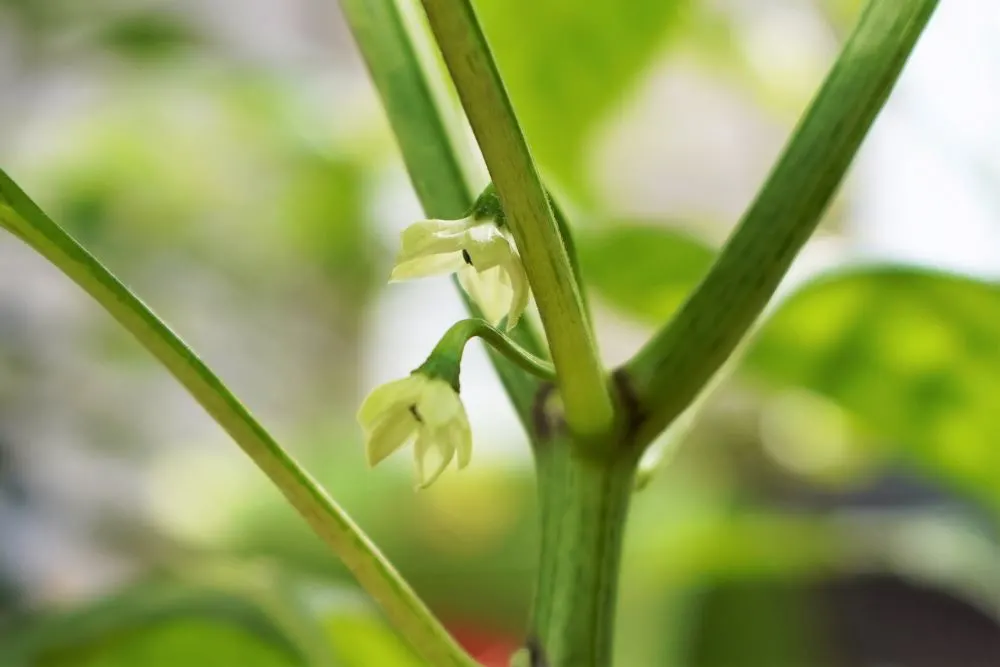
- Hand pollinate flowers. Indoors, pollinators don’t have access to your plants. Thankfully, peppers readily self-pollinate with the help of some wind or a gentle shake of the plant. Be sure to shake the plants daily while flowers are open and producing pollen. Your oscillating fan will help as well.
- Change lighting. Once your plants enter the fruiting stage, change your lights to be on for 12 hours, off for 12 hours daily. By now, the plants should be closer to the lights, and the lights should be at a higher intensity. If your grow light has a switch for ‘bloom’ or ‘fruiting’ stage, turn that on as well. Fruiting pepper plants produce best with more red-shifted light rather than blue-shifted light.
- Pick ripe fruits promptly. Picking peppers that have ripened will help stimulate more productivity. You can let ripe fruits sit on the plants, but removing them is ideal for the best productivity.
If you are having issues with your indoor pepper plants not producing fruit, consider the age of the plant, temperature, lighting, and humidity.
Indoor Pepper Plant Problems
Growing outdoors, nature will often find a way to solve many common problems. Indoors, it is often down to you to identify and fix issues that arise. Here are a few of the particularly common problems when growing peppers indoors.
Plant Edema
We have grown peppers indoors in a variety of conditions and locations, and we always end up with some plant edema. This presents as small, whiteish, crystallized bumps on the bottoms and sometimes tops of leaves.
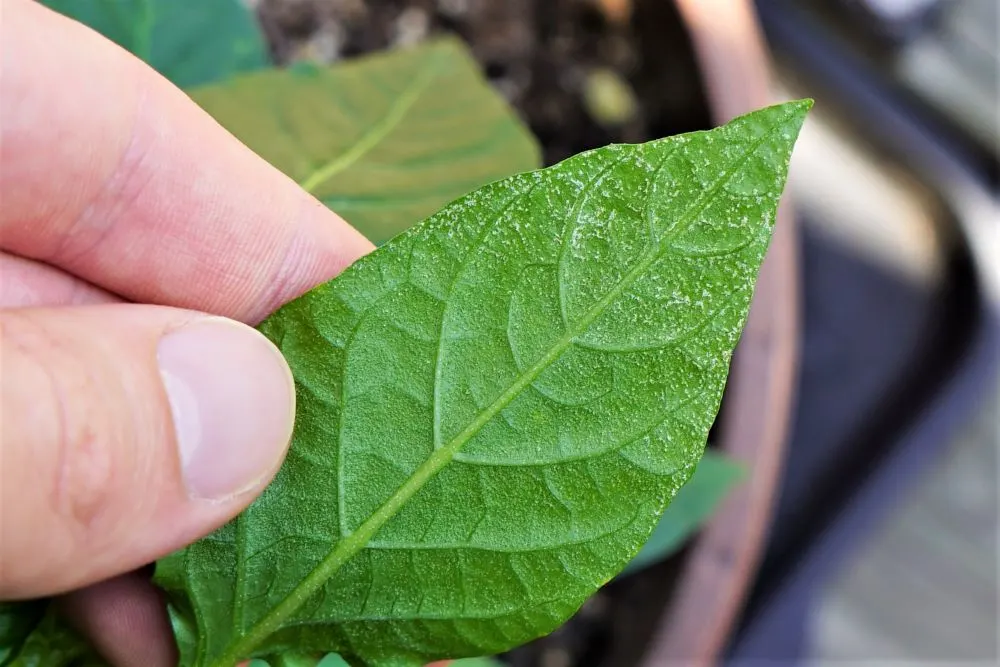
Edema is a water retention issue that is caused by a combination of environmental factors. It is not a disease, and cannot be spread from one plant to another. Airflow and aeration are key to preventing it, so always keep a fan circulating air.
Humidity could also be a culprit for causing edema, so be sure to at least monitor humidity. If it is significantly lower than the ideal range, you may wish to correct it with a humidifier.
Light Burn
Modern LED lights can be very intense, even for pepper plants. If your plants are too close to your lights, they may show signs of light burn (similar to sun scald) or leaf curling.
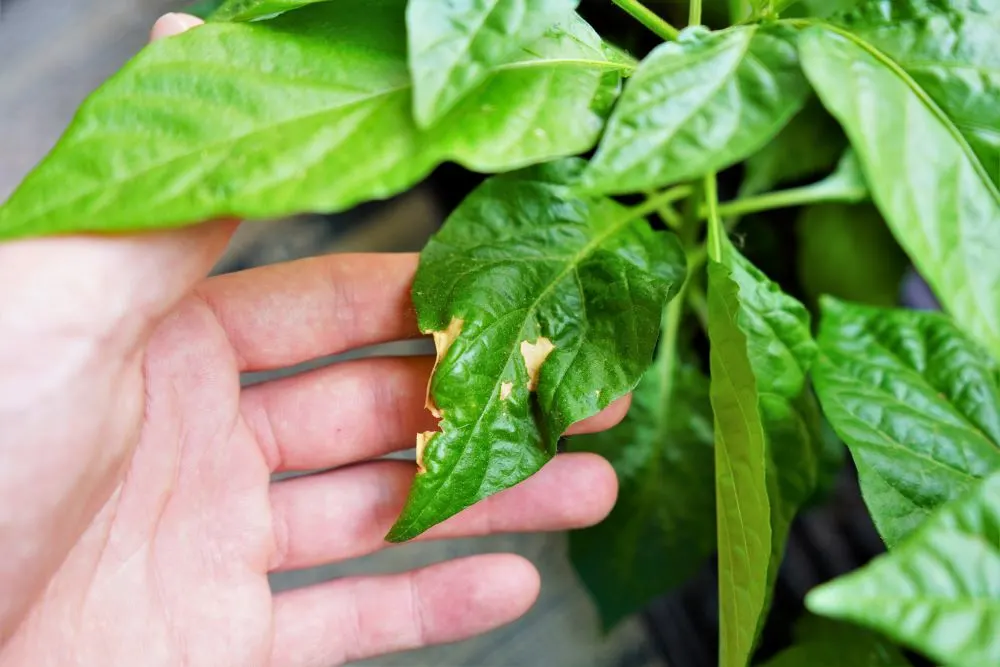
Light burn is most common among young plants. However, as plants grow larger, it is possible for some branches to grow up and come in contact with the grow light. I recommend pruning such branches, or moving the light up to avoid contact.
Too Little Light
Another possible issue is too little light. This issue will be most common for growers who opt to use natural sunlight through a window. Especially in winter, window light is usually insufficient.
Poorly lit pepper plants will have thin and weak stems, while the plants will be taller and less bushy. This is known as a ‘lanky’ or ‘leggy’ plant, caused entirely by low lighting. The solution is to use a strong enough grow light, or to increase the output of your grow light.
Pests
If you bought bagged potting soil, pests are less likely, but still possible. Some insects lay eggs in soil that then hatch and infest your indoor grow space. Outdoor soil brought indoors almost always comes with some form of unwanted insects.
Different pests require different treatment. Aphids and whiteflies can be sprayed off in the sink using a spray nozzle. Remaining insects can be sprayed with a diluted neem oil solution. Be sure to apply this type of spray at dusk when the lights are off.
The best way to deal with pests is to avoid them all together. Just don’t bring soil in from the outdoors – it is not worth the trouble!
Disease
Lastly, disease can cause issues with indoor pepper plants. Stuffy, humid, and warm conditions are the perfect breeding ground for countless bacteria.
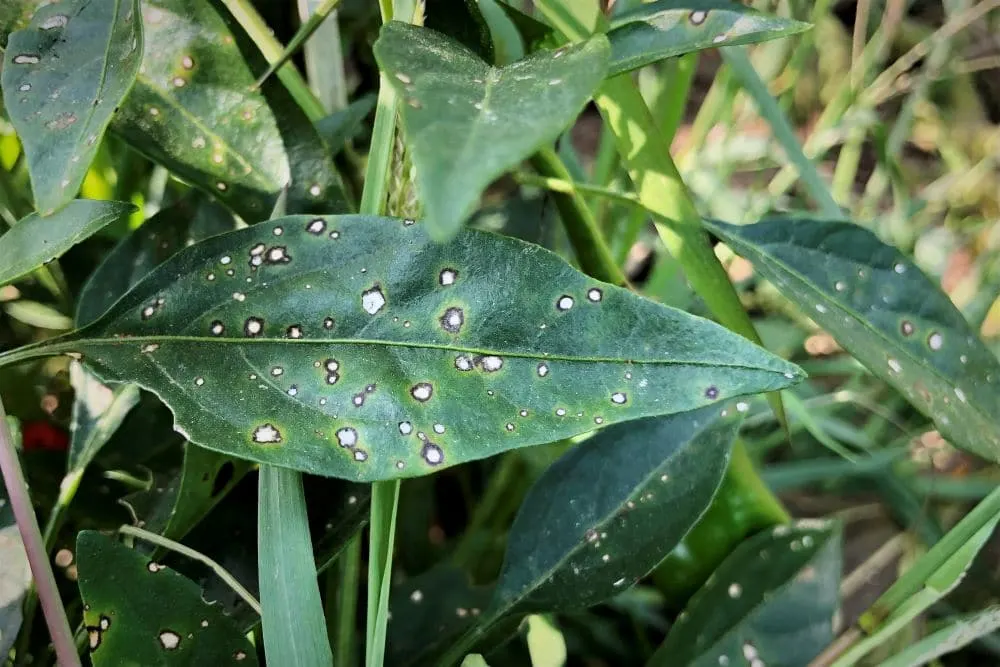
Controlling disease is nearly impossible indoors. Healthy plants can sometimes fight off disease, but if you are certain your plants are sick, it is usually best to dispose of them.
Learn more about pepper plant diseases.
I also recommend sanitizing your grow space after disease has been detected and removed. Diseases can spread from plant to plant, though some plant varieties can be more susceptible than others.
For example, our C. baccatum plants often end up with leaf spot, while nearby C. annuums and chinense plants are unaffected. Still, better to be safe than sorry and remove diseased plants quickly.
Bringing Peppers Indoors from Outside
If you’ve been paying attention, we don’t recommend bringing outdoor soil indoors if you can help it. However, if you want to save some of your outdoor plants for overwintering, it is an option.
First, we recommend overwintering, but not in a grow tent or with a grow light. For us, overwintering is simply a method of keeping a plant alive until it can regrow outdoors next spring. This means cutting the plant back, providing minimal light, and waiting out the cold months in a cool, indoor spot.
How to Overwinter Peppers (Basic Steps)
If your plants are in-ground, dig up the root ball. Then, clean off the roots thoroughly with a hose outside. Do your best to remove all of the soil that is in the roots – this is where many pests and eggs may be hiding.
Then, re-pot the roots in fresh potting soil in a clean pot. Keep the plants in a cool, but not freezing place. This could be a garage, basement, or breezeway with some natural lighting.
Minimal light is required to keep pepper plants alive, though they will not produce fruit. No fertilizer is usually required, as overwintering is essentially a hibernation period for your peppers.
If you want your outdoor plants to produce fruits through winter, follow all of our growing guidelines above. However, be aware that outdoor plants are always a risk for introducing pests.
Conclusions
For some people, indoor growing may be the only option. Cold climates or unpredictable weather conditions may force your growing indoors. However, outdoors is where we always see the best results.
Here in New England, growing peppers indoors is mostly a way to keep ourselves occupied in winter. However, it can certainly be a year round hobby. Peppers are naturally perennial, meaning they can be kept alive for years and years when cared for properly.
Read Next:
I hope this article helps you achieve success with your indoor pepper plants! Let us know any of your tips or suggestions for indoor growing in the comments below.

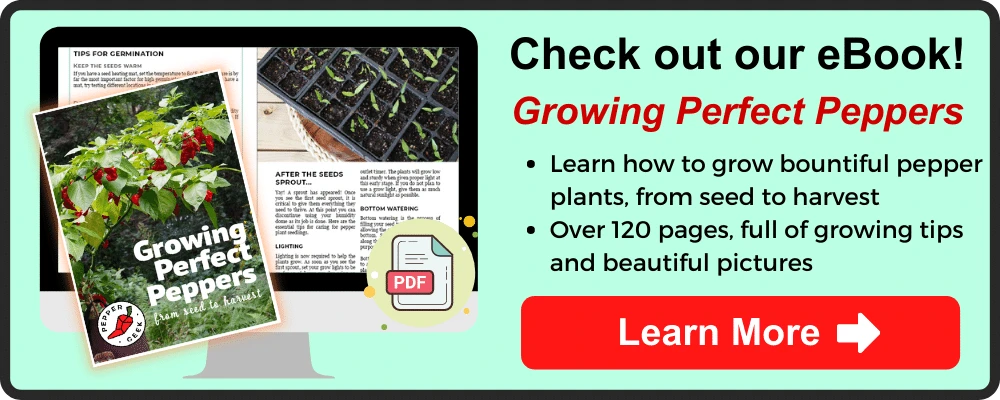
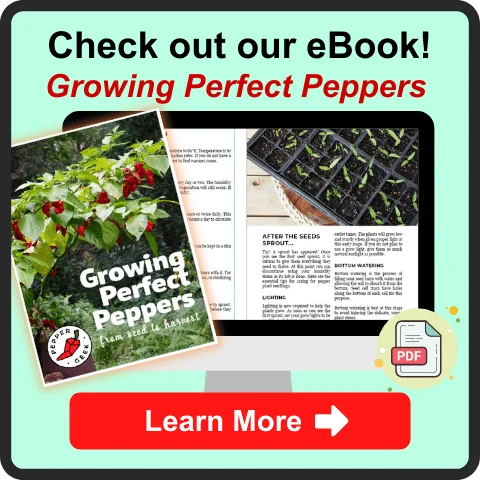

Melissa
Monday 19th of February 2024
I am in my 4th year of planting sweet peppers & 1 jalapeño for myself. This week I just started my seeds indoors & upgraded my setup with a heat mat with thermostat & led grow lights. I am in Michigan & with temps all over humidity in house is an issue. I have starting trays with humidity domes. I am unsure what humidity level I should be at for this point. I have heat mat set at 77 right now. My sensors say the temp in the domes is 73F with 76% humidity. Is this too much? Thank you
peppergeek
Wednesday 21st of February 2024
That temp/humidity is fine for germination, ideally a bit warmer in the soil. Once they sprout, I would remove the dome and the heating mat, unless it is especially cold in your house. Then, the heating mat may be slightly helpful.
Bob
Tuesday 9th of January 2024
Hi Calvin, I have been growing peppers for about 10 years and I find your information extremely helpful and enjoy the recipes very much. Please keep them coming. FYI, I live in North Carolina and I have never hardened my pepper plants but I do get excellent results. I start seedlings indoors mid-to-late January then move directly outdoors mid-to-late April. I'm harvesting peppers from July through end of season. One question: my Cow Horns aren't doing as well as they did a few years back and they are not as commonly available as they used to be (plants at big box stores or garden stores). Are you aware of any issues? Always one of my favorites. Thanks, Bob
peppergeek
Wednesday 10th of January 2024
That's great - thanks for reading our content! Glad you get good results in NC. As for the cow horns, I usually see them for sale in the spring. We tried "Carmen" last year from seed (you can get them here), and had impressive results and flavor. However, these are sweet, not spicy. If you haven't seen them my only guess would be that the supplier discontinued the variety, or the stock was lower than usual. Haven't heard anything otherwise.
Matt
Sunday 5th of November 2023
Hi Calvin, Thanks For your site. Some of the best and most useful information I found about growing peppers! I have a Padron pepper that I brought in from outside in fall of ‘22, and the place I’m in now is a high floor with full sun, SE corner and large windows. Other than the plant edema you discussed, it seems to be thriving. Lots of peppers, tapering off production a bit now. The question I have is it’s getting so bushy but it seems to wilt if I don’t water it every couple of days. Currently the plants about 20 inches tall and about 30 inches wide, and it’s sending out branches laterally. How big will these guys get if left in the wild? It’s been about a 2- 3 gallon pot right now. wondering to repot it into something larger or just prune it down. It needs water so often that it makes me wonder if the plant is just larger than the root system can support? Thanks for any thoughts or advice! Matt
peppergeek
Saturday 16th of December 2023
Hi Matt, That sounds like a great little plant. Most peppers can grow to be very large in ideal conditions, at least 4-5 feet tall. Indoor plants do tend to need more frequent watering, especially when they reach a mature size for their growing container. If you don't want the plant to get too large, I'd say keep it in the smaller pot and keep up on watering. If you up-pot, eventually it will fill out the soil in the larger pot and still need regular watering. The dry indoor air doesn't help either. -Calvin
Erich
Friday 3rd of November 2023
Hey Calvin!
Firstly I want to thank you for acting as an incredible resource. I've learned so much from your content.
Secondly, I'd love your advice on an issue I'm having growing peppers indoors. My hot peppers are doing well in 3 gallow grow bags in a grow tent, but I live in a dry climate (~35% humidity currently) and the inline fan consistently brings cool basement air into the tent (~60 degrees). How would you recommend implementing a humidifier and heater without attempting to heat/humidify 1000sqft? Happy to run timers to get things in line.
Thanks so much in advance!
Erich
Tuesday 7th of November 2023
@peppergeek,
Thanks so much, Calvin.
The Tim Taylor in me went for it. Keeping humidity ~65% and temps in the mid 70s currently, geared more towards my annuum vs chinense. The biggest inefficiency seems to be the loss of temp/humidity when pulling fresh air into the tent, which occurs hourly. Are there any guidelines for CO2 turnover per plant? I'd love to run air exchange less often if possible, but it seems most of the literature online is geared towards growing psychoactives.
Thanks again!
peppergeek
Friday 3rd of November 2023
This is what makes growing peppers indoors a challenge. Ideally, you'd have temps around 75-80°F. You can definitely achieve this with a small heater and humidifier, paired with a thermostat plug and humidistat plug. It's up to you if you think it is worth the investment for such a small space, but this is the way it's typically done for serious indoor grows. Thanks for the kind words, and best of luck!
Linda
Sunday 24th of September 2023
I decided to overwinter 17 potted superhot pepper plants last fall. Of them all, 5 made it thru to this summer and produced amazing amounts of peppers. I did nothing special, just cut them back when I brought them inside and then put them out in the spring. They are ghost peppers and carolina reapers. I was pleased with the ones that survived but I'm not gonna do this again. (I had a dining room with 17, 8 gallon pots.) I am going to see if anyone wants the plants to put in their greenhouse or whatever. It certainly can be done and I probable would've had a higher success rate if I put more effort into it. Good luck to whoever decides to give it a try!